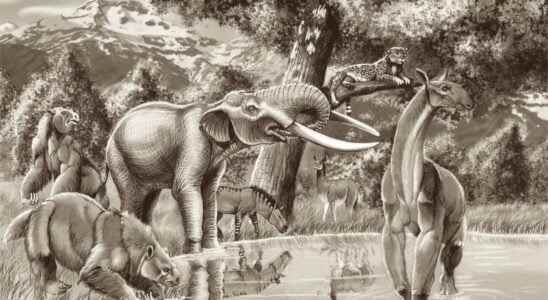Tag: Fossil
Brachiosaurus: what is it?
Brachiosaurs are among the largest and heaviest animals to ever walk the Earth. The erect necks of these giant sauropods allowed them to feed on leaves at the tops of…
The surprising last meal of a giant Cretaceous crocodile
You will also be interested [EN VIDÉO] Crocodile, alligator and caiman: what’s the difference? We often confuse crocodile, alligator and caiman. They all belong to the order of crocodilians, but…
The Life Of This Cockroach Trapped In Amber 100 Million Years Ago Was Different From Those Of Today
Dorsal (a) and ventral (b) views of H. today in amber, (c) frontal view of the head of H. today, (d) antenna, (e) 3D model of the head of H.…
100 million year old cockroach found in exceptional condition with eyes intact
Dorsal (a) and ventral (b) views of H. today in amber, (c) frontal view of the head of H. today, (d) antenna, (e) 3D model of the head of H.…
New species of a fossil group discovered a century after the first
A fossil species previously thought to be a radiodont, a Cambrian nektonic predator, has just been reanalyzed. Its morphology allows paleontologists to classify it among the opabiniids, the last specimen…
The major European banks continue to massively finance fossil fuels
25 of the main European banks have provided 55 billion dollars to companies that develop oil and gas production in 2021. This is the observation of the NGO ShareAction which…
A Miocene site filled with faecal pellets
In the Miocene of Maryland, mysterious organisms left traces of their meal behind. They filled a fish skull, a gastropod shell and the insides of barnacles with it. You will…
A 35,000-year-old mega-herbivore closer to elephants or mammoths?
35,000 years ago, the proboscideans Notiomastodon platensis populated South America. The removal of ancient DNA from a molar of one of the representatives of this species makes it possible to…
Mapping global methane emissions from fossil fuels
Methane is the second greenhouse gas with a release of 97 million metric tons per year. To follow the evolution of its emissions, scientists have established maps from the observations…
Mapping of methane emissions from fossil fuels
Methane is the second greenhouse gas with a release of 97 million metric tons per year. To follow the evolution of its emissions, scientists have established maps from the observations…







